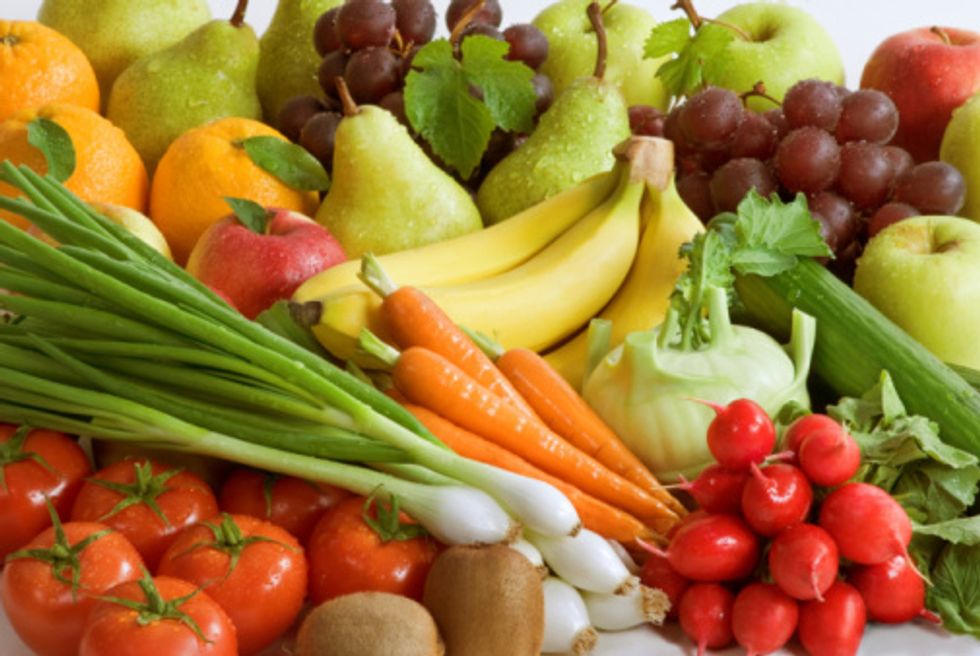
Poor diet is one of many factors contributing to high blood pressure and other chronic diseases, and it is one we can control for ourselves and our families. While we in the United States suffer from an overabundance of food—and therefore cope primarily with overweight and obesity causing multiple health problems—some people in this country and around the world face hunger. Both problems can be linked with diets lacking in nutrients.
In honor of World Health Day, Food Tank: The Food Think Tank is highlighting the importance of nutritious, environmentally sustainable food in combating hypertension, obesity, malnutrition and other diseases.
Danielle Nierenberg, cofounder of Food Tank, offers these strategies for creating healthier food and agriculture systems. Some of her recommendations address farming and agriculture, but they are all good food for thought.
1. Eat more vegetables and fruits.
The U.S. Department of Agriculture (USDA) recommends three to four servings of fruit and four to six servings of vegetables every day. Eating less than that can result in getting 80 percent fewer nutrients than are needed to maintain a healthy diet. Failing to meet these guidelines increases the risk of heart attack, stroke, obesity and some cancers. Choose foods high in nutrients and low in calories.
2. Strengthen soil with intercropping and cover crops.
Many essential nutrients come from the soil, making soil health critical to producing nutritious food. Even if you just plant a backyard garden, be sure to enrich your soil. You may want to try intercropping with legumes, such as alfalfa or peas, to help return nitrogen to the soil or using cover crops, which can be ploughed into the ground and return nutrients to the soil.
3. Know your nutrients.
Kale, sesame seeds, dried figs, salmon and broccoli are excellent sources of calcium. Dark green, leafy vegetables are also rich in vitamin K, which is similar to vitamin D in the way it helps the human body make the most of the calcium in food.
See our Nutrition Guide.
4. Support family farmers.
Small and medium-scale family farms are more likely than big farms to produce nutrient-rich crops, using practices that help keep nutrients in the soil. Buying food at farmers markets and joining a CSA are good ways to support family farms and help build the local economy.
5. Choose whole grains.
Whole grains are valuable, low-cost sources of protein and fiber and can help reduce the risk of heart disease, cancer, type 2 diabetes and other diseases. However, they still make up less than the recommended half of total grain use in the United States. When shopping, look for 100 percent whole wheat or 100 percent whole grain. Check to see if the first ingredient listed is whole wheat, whole meal or whole corn.
6. Eat out less.
The Natural Resources Defense Council (NRDC) reports that some American restaurants serve portions up to eight times the size recommended by the USDA and U.S. Food and Drug Administration. Eating home-cooked meals is an easy way to manage portion sizes and calories.
7. Buy and grow organic.
Research shows that organic fruits and vegetables have equal or greater nutrient content than the same conventional produce. The Environmental Working Group publishes an annual Shopper's Guide assessing which fruits and vegetables have the most pesticides. In 2012, apples, celery and sweet bell peppers were in the top three; however, onions, sweet corn and pineapples were among the safest foods to buy as conventional.
8. Choose grass-fed meat.
Lean meat can contain many valuable nutrients that support a healthy diet. Grass-fed meat usually has less fat than conventional corn- and grain-fed meat products. The Mayo Clinic reports that grass-fed meat has higher levels of omega-3 fatty acids, linoleic acid and antioxidant vitamins, such as vitamin E.
9. Support indigenous, heritage and heirloom.
A study from the University of Texas, Austin found that the amount of nutrients in 43 food crops have significantly decreased since 1950, largely due to the emphasis on crop yields. Heritage breeds of farm animals and heirloom plant varieties, which have not been bred for increased yields, have the potential to be much more nutritious.
(Note: Food Tank: The Food Think Tank (www.FoodTank.org), founded by Danielle Nierenberg and Ellen Gustafson, is a think tank focused on feeding the world better. It researches and highlights environmentally, socially and economically sustainable ways of alleviating hunger, obesity and poverty and create networks of people, organizations and content to push for food system change.)
Search powered by AI

Marcia Mangum Cronin
Marcia Cronin worked for HealthyWomen for over 15 years in various editorial capacities. She brings a strong background in copy editing. She graduated from the University of North Carolina at Chapel Hill with a bachelor's degree in journalism and worked for over two decades in newspapers, including at The Los Angeles Times and The Virginian-Pilot.
After leaving newspapers, Marcia began working as a freelance writer and editor, specializing in health and medical news. She has copy edited books for Rodale, Reader's Digest, Andrews McMeel Publishing and the Academy of Nutritionists and Dietitians.
Marcia and her husband have two grown daughters and share a love of all things food- and travel-related.
Full BioLearn about our editorial policies
Marcia Mangum Cronin
Marcia Cronin worked for HealthyWomen for over 15 years in various editorial capacities. She brings a strong background in copy editing. She graduated from the University of North Carolina at Chapel Hill with a bachelor's degree in journalism and worked for over two decades in newspapers, including at The Los Angeles Times and The Virginian-Pilot.
After leaving newspapers, Marcia began working as a freelance writer and editor, specializing in health and medical news. She has copy edited books for Rodale, Reader's Digest, Andrews McMeel Publishing and the Academy of Nutritionists and Dietitians.
Marcia and her husband have two grown daughters and share a love of all things food- and travel-related.